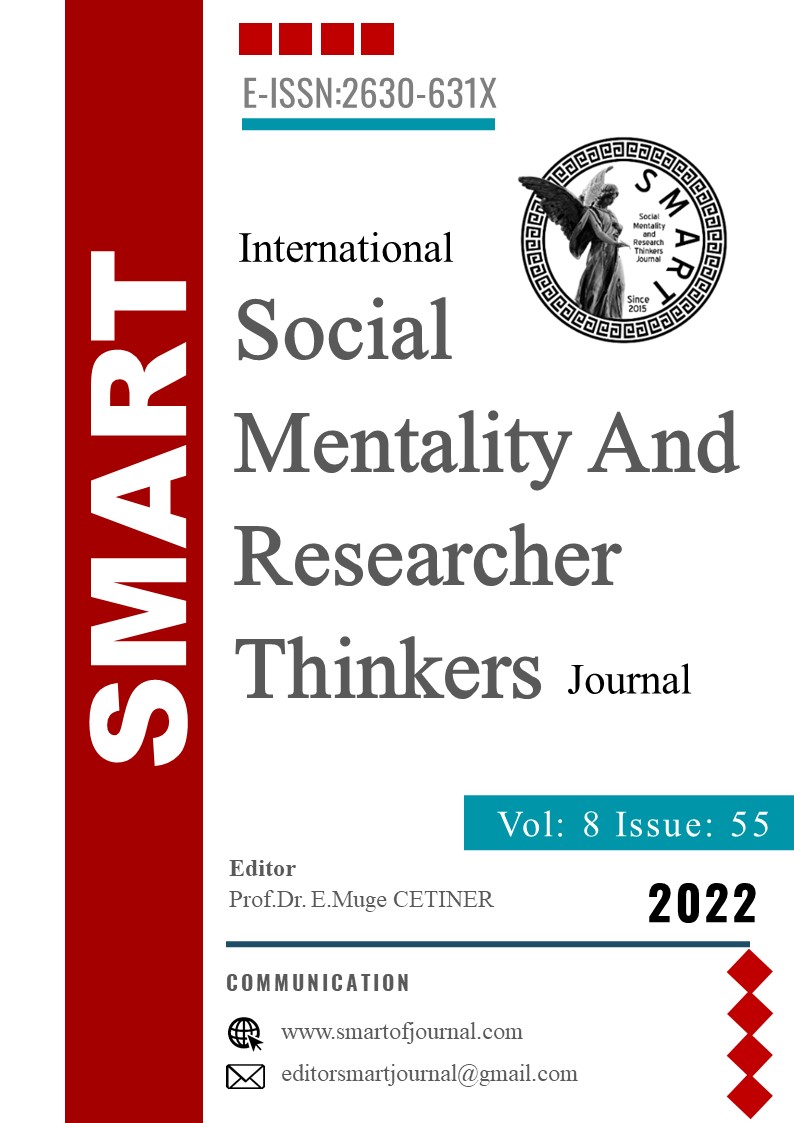Author :
Abstract
Son dönemde dijital platformlar sinema ve dizi izlemek amacıyla yoğunlukla tercih edilen platformlar haline gelmiştir. Çalışma kapsamında Netflix üzerinden yayınlanan 7+ yaş grubuna hitap ettiği belirtilen çocuk sinema filmlerinde özellikle kullanılan göstergebilimsel kavramların Japon Anime filmleri üzerinden analiz edilmesi amaçlanmaktadır. Japon animasyonlarında özellikle kullanılan göstergeler üzerinden araştırma çalışması devam ettirilmiştir. Göstergebilim çalışmalarında önemli bir yere sahip Roland Barthes, John Locke kuramsal çerçevenin temelini oluşturmaktadır. Ayrıca Jean Baudrillard’ın Simulakrlar ve Simulasyon eserinden, Stuart Hall’ün Kültürel Temsiller ve Anlamlandırma Uygulamaları eserinden faydalanılmıştır. Animasyonlar üzerinden kullanılan göstergebilimsel temsiller aslında toplumsal norm ve kültürü devam ettirme niteliği taşımaktadır. Özellikle Roland Barthes’ın Japon kültürünü incelediği göstergelerden oluşan bir kültürü anlatan çalışması Göstergeler İmparatorluğu eseride çalışmada önemli bir yere sahip olmaktadır.
Keywords
Abstract
Recently, digital platforms have become the most preferred platforms for watching movies and TV series. Within the scope of the study, it is aimed to analyze the semiotic concepts used in children's movies, which are stated to appeal to the 7+ age group on Netflix, through Japanese anime movies. Research work has continued on the indicators used especially in Japanese animations. Roland Barthes, who has an important place in semiotic studies, forms the basis of the John Locke theoretical framework. In addition, Jean Baudrillard's Simulacra and Simulation and Stuart Hall's Cultural Representations and Applications of Signification were used. Semiotic representations used through animations actually carry the quality of maintaining social norms and culture. Especially Roland Barthes's work The Empire of Indicators, which describes a culture consisting of signs in which he examines Japanese culture, has an important place in the study.
Keywords
- Akşit, O.O. (2017). “Japon Anime Sinemasında Modernite Eleştirisi: Fantezi ve Bilimkurgu Animeleri
- Akşit, O.O. (2017). “Japon Anime Sinemasında Modernite Eleştirisi: Fantezi ve Bilimkurgu Animeleri Üzerine Bir İnceleme”, Akademik Sosyal Araştırmalar Dergisi, 5(55), 120-133.
- Baudrillard, J. (2011). Simulakrlar ve Simulasyon, Doğu Batı Yayınları, İstanbul.Barthes, R. (1979). Göstergebilim İlkeleri, Kültür Bakanlığı Yayınları, Ankara.
- Barthes, R. (1996). Çağdaş Söylenler, çev: Tahsin Yücel, Metis Yayınları, İstanbul.
- Barthes, R. (2016). Göstergeler İmparatorluğu, çev: Tahsin Yücel, Yapı Kredi Yayınları: İstanbul.
- Hall, S. (2017). Temsil Kültürel Temsiller ve Anlamlandırma Uygulamaları, Pinhan Yayıncılık, İstanbul.İlkdoğan, H. (2017). “Göstergenin Toplum Düzlemindeki Yeri: Toplumsal Göstergebilim”, İdil Dergisi, 6(39), 3147-3164.
- Karaman, E. (2017). “Roland Barthes ve Charles Sanders Peirce’in Göstergebilimsel Yaklaşımlarının Karşılaştırılması” İstanbul Aydın Üniversitesi Dergisi, 34, 25-36.
- Özmakas, U. (2009). “Charles Sanders Peirce’in Gösterge Kavramı” Uşak Üniversitesi Sosyal Bilimler Dergisi, 2(1), 32-45.
- Sağlık, A.; Temiz, M.; Kasniç, G.& Kelkit, A. (2021). “Hayao Miyaziki’nin “Rüzgarlı Vadi, Komşum Totoro,Rüzgar Yükseliyor” Animelerindeki Peyzaj Unsurlarının İncelenmesi ve Değerlendirilmesi”, Atatürk Üniversitesi Güzel Sanatlar Fakültesi Dergisi, 360-374.
- Sarban, S. (2011). Mangadan Animeye: Japonya’nın Yumuşak Güç Silahlarından Biri olarak Sen To ChihiroNo Kamikakushi Filminde Tüketim Nesnesi Sunumu: otomobil Örneği, Yüksek Lisans Tezi, İstanbul Kültür Üniversitesi Sosyal Bilimler Enstitüsü, İletişim Tasarımı Ana Bilim Dalı, İstanbul.
- Ünal, M. F. (2016). “Göstergebilimin Serüveni”, Mütefekkir Aksaray Üniversitesi İslami İlimler Fakültesi Dergisi, 3(6), 379-398.





